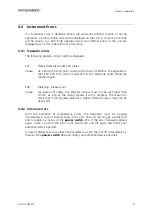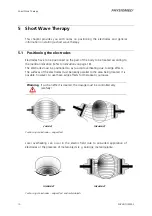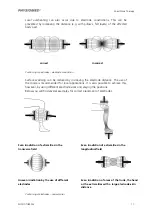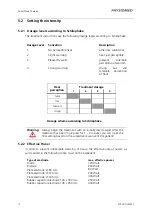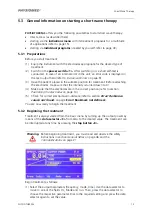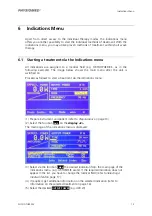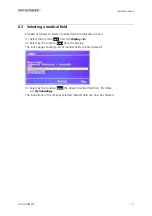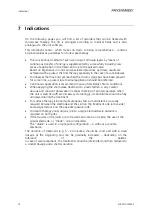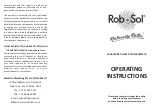
Introduction
PHYSIOTHERM-S
3
•
Implants that could be impaired by short-wave irradiation
•
Swellings that still feel warm
•
Thermohyperesthesia
•
Thermohypesthesia
•
Acute inflammations
•
Severe arterial obstructions (stage III and IV)
•
Gynaecological disorders involving acute inflammation
•
Wetness, perspiration or damp bandages
•
Permeating irradiation of the thorax in cases of severe heart diseases (heart valve
diseases, myocardial insufficiency, myocardiac infarct, severe coronary sclerosis)
•
Pregnancy, since irradiation of the abdomen could cause teratogenous damage
due to alterations of blood circulation and diffusion
•
During the menstrual cycle
•
Sudeck’s syndrome, stage I and II
•
Basedow’s disease (irradiation could cause serious states of agitation)
•
Varicose veins (irradiation could cause congestive pain)
1.3.3
Of particular importance
Particular care must be taken if the patient’s clothing is wet or damp, since the
garments may heat up faster and more intensely than the patient’s body. Synthetic
fibres (perlon, nylon, etc.) are characterized by low absorbency, which can cause the
skin beneath such fabrics to quickly become moist. Therefore, it is recommended
that the body areas to be treated be completely unclothed and the patient’s skin
dried, particularly where perspiration accumulates in folds of the skin. This applies
especially when a higher dosage is being applied. There is no danger, however,
when applying short-wave irradiation to bandaged areas as long as the bandages
are completely dry.
•
When treating small children, particular care is obviously required, due to the
low body weight. Very careful dosing and constant observation (manual checks
of the skin temperature while the unit is switched off) are necessary.
•
Since the effects of high-frequency fields on unborn life have not yet been
sufficiently researched, we recommend that operators who are pregnant do not
remain in the immediate vicinity of the applicator when the unit is activated.
•
The output power must always be set according to the subjective response of
the patient! Therefore, special care must be taken in case of patients with a
diminished capacity for perception of heat (refer to section
on page 12).
Warning
We would like to point out that it is advisable to post warnings for
wearers of pacemakers in the rooms where high-frequency
therapy (e.g. short-wave therapy) is applied.
Moreover, a distance of at least 6 meters must be maintained
between the unit and any low-frequency therapy that is being
carried out at the same time!
2
The higher conductivity of metals causes concentration of the field, producing a high temperature in the border area
of the tissue. This in turn can cause excessive local heat, leading to (irreparable) third-degree burns. Therefore, caution
is also necessary in case of long-existing metal inclusions, such as shell fragments.
3
Further contraindications relating to gynaecological disorders include (see Möbius, Gynaecological University Clinic,
Jena): genital tuberculosis, endometriosis, pyosalpinx or pyo-ovarium, tubal carcinoma.

















